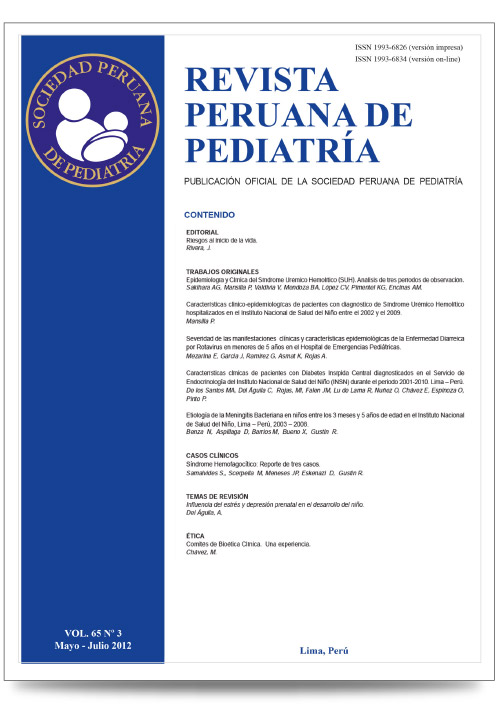Clinical and Epidemiological Characteristics of Patients with Diagnosis of Hemolytic-Uremic Syndrome Hospitalized at the Instituto Nacional de Salud del Niño between 2002 and 2009
DOI:
https://doi.org/10.61651/rped.2012v65n3p122-130Keywords:
Hemolytic Uremic Syndrome, Acute Renal FailureAbstract
Objective: Determine clinical and epidemiological characteristics of patients with Hemolytic-Uremic Syndrome (SHU).
Methods: A descriptive, retrospective, longitudinal study. Were included patients with diagnosis of SHU, hospitalized in the INSN from January 1, 2002 until December 31, 2009. Population: 174 patients.
Results: The hospitalary incidence rate (TIH) was 2.01 per 1000 hospitalized children. 57% were male patients. The most frequently age group at presentation was 13 to 18 months, 77% of the patients were younger than 25 months of age, with a median age of 18 months. The 85% of the patients came from Lima and Callao. Seasonal incidence with bimodal trend spring- summer was observed in 67% of the cases. The median time of diarrhea duration was 7 days (range 4). The 97% of the patients presented diarrheal prodrome with a median duration of 7 days, 77% of these had bloody diarrhea; 90% of the all patients received previous antibiotic treatment. In the 85% of the patients SHU develops during the diarrheal prodrome. 76% of the all patients presented SHU classic triad. 72% had arterial hypertension, 28% seizures and 65% severe anemia. 61% of patients presented oliguric acute renal failure (ARF). 46% required dialysis. The patients were hospitalized for a median of 13 days (range 10). The lethality was 2.3%.
Conclusions: The TIH has increased significantly (4 times more than the five year period 1982- 1986). The most frequent age was under 25 months, with median age of 18 months. Increase of patients proceeding from other regions of the country (15%). Seasonal incidence with bimodal trend spring-summer. Predominance of the typical variety of the HUS (D+). The SHU develops during the diarrheal prodrome. Predominance of the SHU classic triad. Increase of the nonoliguric ARF (39%). The lethality was similar to another Latin- American literature.
Downloads
Downloads
Published
How to Cite
Issue
Section
Categories
License

This work is licensed under a Creative Commons Attribution 4.0 International License.
Authors will retain the copyright and grant the right to publish their work in the journal while allowing third parties to share it under the Creative Commons Attribution license.
Articles are published under a Creative Commons license that allows sharing and adaptation with appropriate credit. CC BY 4.0 license. Available in English at https://creativecommons.org/licenses/by/4.0/
Authors may use other information disclosure formats as long as the initial publication in the journal is cited. The dissemination of the work through the Internet is recommended to increase citations and promote academic exchanges.
The published content does not necessarily reflect the specific point of view of the journal, and the authors assume full responsibility for the content of their article.




